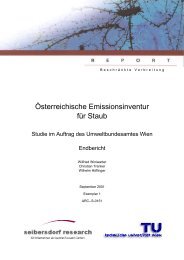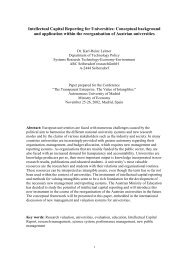ALPMON FINAL REPORT - ARC systems research
ALPMON FINAL REPORT - ARC systems research
ALPMON FINAL REPORT - ARC systems research
Create successful ePaper yourself
Turn your PDF publications into a flip-book with our unique Google optimized e-Paper software.
Contract ENV4-CT96-0359 <strong>ALPMON</strong><br />
area of interest within 7 days. Apart from our fundamental doubts, growing from our experiences with data<br />
availability of operational <strong>systems</strong> of the last twenty years, Landsat, Spot but also IRS, with swath width<br />
larger for the factor 6 to 17, this is only to be realised by changing the view angle from path to path. This<br />
directly led to the necessity to adopt and improve the existing geocoding as well as topographic /<br />
atmospheric correction software.<br />
Data preparation<br />
Image fusion techniques as applied in the project can improve significantly the quality and accuracy of<br />
land cover classification. However, the type of land cover objects that actually benefit from fusion<br />
techniques is still somewhat limited. In particular the loss of texture information for the price of spectral<br />
preservation is a drawback. Recent <strong>research</strong> results have shown that image fusion based on wavelet<br />
transform preserve both texture and spectral information.<br />
Image analysis with special respect to the new sensor generation<br />
With the acquisition of high-resolution data, which with the launching of IKONOS has only been made<br />
available at the end of <strong>ALPMON</strong>, there will be an increased need of appropriate processing algorithms.<br />
High-resolution data produces increased variance of objects, thus new classification methods need to<br />
cope with this increased variance.<br />
The problem of high pixel value variance characterising objects of interest in high resolution remote<br />
sensing data prohibits the automation of evaluation chains for data with geometric resolutions in the „m“<br />
scale (airborne scanner data, Ikonos, Quick Bird, etc.) with conventional commercial software <strong>systems</strong>.<br />
Traditional image analysis software follows the feature space concept. Pixel by pixel the whole image is<br />
sorted into classes, according to their DN value in the spectral domain, which defines their position in the<br />
feature space. The results are X classes with Y number of pixels. Clusters of pixels of the same class are<br />
interpreted to belong to one object. The location of the objects is unknown. The statistics are calculated<br />
class-wise.<br />
On image processing level object oriented classification approaches, based on spectral as well as on<br />
textural and shape parameters and being able to use context as well as auxiliary information in<br />
classification process wake expectations in more accurate classification results. Two new software<br />
packages shall be mentioned in this context: the ClassTool currently developed at Joanneum<br />
Research, and the Delphi2 eCognition. LMUs 20 month experiences with eCognition (Buck et al., 1999,<br />
a,b, de Kok et al, 1998, 1999 a,b, Schneider et al., 1999, 2000) proves, that this software is able to solve<br />
or at least to bypass some of the bottlenecks of conventional image processing:<br />
� methodology for the automatic classification of high resolution satellite data<br />
� methodology for data fusion, data merge, image fusion, data concatenation, sensor merge,<br />
resolution merge<br />
� the scaling problem.<br />
Furthermore, the ClassTool software currently developed at Joanneum Research, is a very flexible tool<br />
which is specialised for feature definition and extraction, shape extraction, segmentation, statistical<br />
analyses, and object based classification with various classification algorithms.<br />
The concept of object oriented <strong>systems</strong> is different in some key positions. Object oriented image analysis<br />
<strong>systems</strong> starts with an image segmentation. Usually the segmented image is than stored as bitmap. The<br />
innovative step forward made by programs like the tested Delphi2 eCognition is to store the statistics<br />
calculated for creating a segment for each object as a attribute table. This, on the first view trivial solution,<br />
opens the door to the GIS world. First, each segment is defined by its location and becomes an object<br />
with properties stored as attribute table, and, second, the objects can now be selected by .sql queries of<br />
relational data base <strong>systems</strong>. GIS layers, respectively the connected data bases can directly be integrated<br />
into the search. This way the problem of data merge is practically solved. Additionally, the fuzzy logic<br />
classification tools of eCognition approach the week “natural” transitions in alpine environment much<br />
better than the Boolean logic of conventional image processing software packages.<br />
The task driven definition of hierarchical evaluation rules becomes the key ability for image analysis.<br />
Which are the advantages of an object oriented system for monitoring <strong>systems</strong> ?<br />
Having the duty to administrate area covering objects like forests (forest management), lakes, river and<br />
riverbeds (water management), agricultural plots, biotops (environmental survey), a.s.o., the most<br />
effective way is to do it object-wise. Normally for each area, defined as an object of interest, a data base<br />
has been established at the moment this object is assigned to an administration. Searching for<br />
information about an area it is sufficient to know its Id No. or geographic location.<br />
JR, RSDE, ALU, LMU, Seibersdorf, WSL 88




